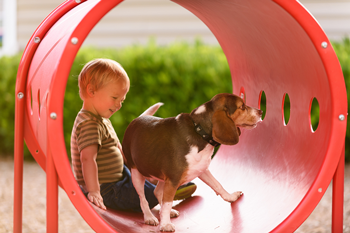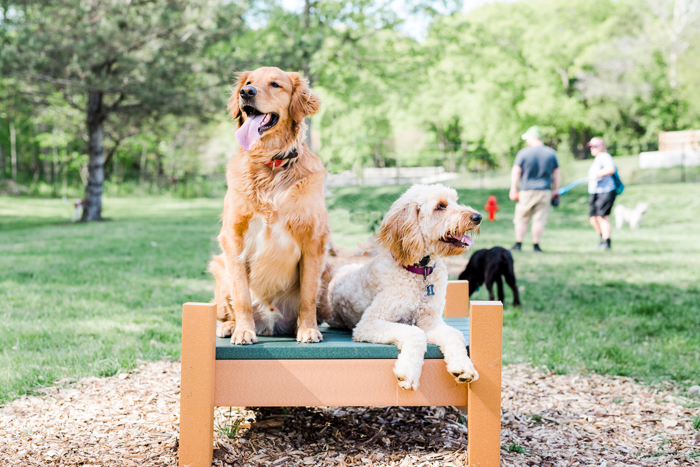By Harrison Forbes
Dog parks have been transformed! Gone are the days of just “fence and bench” designs. Today’s pet lovers want more, and modern communities can meet their expectations with thoughtful planning and wise investment.
Pet parents want not only resort-like amenities such as obstacle courses, wash bays and comfortable, shaded seating for the people. Dog parks have also become a hub for social activity—-a gathering place for dog lovers with “Yappy Hours,” training seminars, costume contests, holiday photo ops and welcome wagon events for people and their dogs who are new to the area. In most upscale apartment complexes nationwide, pets outnumber children!
With the rise of this furry tide have come elevated expectations, and choices among all the endless options can be frustrating. Planning a dog park is unlike a sports field that has a prerequisite dimension and size. One is bound only by imagination, budget and available space.
After being involved in consulting, designing and building more than 300 dog parks nationwide, I have observed that no two are the same. Let’s start with the basics, the trends and the bonus bells and whistles.
At a basic minimum, a park should have separate large dog and small dog areas, typically a 1/3 to 2/3 ratio or 75%-to-25% split, depending on the size makeup of the dogs in your area. Space should include seating inside each area, waste stations spread throughout and two to four pieces of play equipment.
The surface you choose depends on climate and budget. Fantastic synthetic turfs are currently available.

Play equipment involves a behavioral learning curve that I spend much educational time on. While basic exercise can happen in an empty yard, real enrichment and play happen in a well-designed and equipped park. Pet parents can forge stronger bonds with their pets using products that are not only fun but help teach basic obedience, simple commands, etc. It’s a meaningful way to get to know your dog better—-what makes them tick and how they learn. It also builds a pleasant play-engaged relationship.
Consider function. This is more than merely nuts-and-bolts design. Dog parks are embracing a larger role of creating a community hub of dog activity and exciting events, such as having local trainers give free monthly seminars, hosting seasonal parties like Howl-o-Ween or Santa Paws, adoption events, meet and greets, etc. From a design standpoint, dog parks are being built on rooftops, in alleys, under road overpasses , along wooded ditch lines and on converted tennis courts.
One of the best new trends that as a behaviorist I hope is widely adopted is the creation of a third section of a dog park. This can be much smaller and simpler with a bench and waste station. It has been called different names, but the function is the same. It is for dogs with special needs, dogs with mobility issues, post-surgery dogs or dogs that have anxiety and are not ready for open play. I have coined a term for this section—
“singles only”—and suggest a time limit of 10 to 15 minutes so many people can use it. My office is now across from a busy dog park that has many apartments nearby. I see people walk up daily with their dog and stop short of entering because the park is too full, and they end up coming back when it’s empty or has fewer animals. The third section for “singles only” allows for everyone to enjoy and eases anxious or new dogs to the dog play environment.
Most dog owners grossly underestimate the amount of exercise their dog needs. A dog off leash, sprinting and running is the best source of exercise and joint conditioning you can have. Dogs are also pack animals, and despite our human egos thinking we give them everything they need, there is no substitute for a dog interacting and engaging with other dogs to complete them mentally and physically.
The best news of all is that with rising expectations for better dog parks, there are plenty of great examples to model. I encourage anyone adding a new dog park to go visit and talk to other municipalities that have fantastic parks. Ask lots of questions and gain key insights before throwing together a new plan. With more than 2,000 dog parks nationwide and growing, there is a massive body of work showing what to do and what not to do. Spending an afternoon talking to a park supervisor and asking several patrons what they like and dislike is time well spent. Do your research, ask questions and go build a fantastic 3.0 level destination dog park that is the talk of your town and the envy of surrounding communities! RM
ABOUT THE AUTHOR
Harrison Forbes has worked in the pet industry for more than 25 years, first as a K-9 dog trainer and importer of police and military working dogs and then as host of the popular radio show Pet Talk . He wrote the bestseller “Dog Talk” in 2008 and has appeared over 50 times on national television as a renowned pet expert. Forbes is the director of the Dog Park Dash grant program, which has awarded more than $4 million to communities and built over 120 dog parks. He has served as spokesperson for Playcore/UltraSite for 4 years and regularly consults on dog
parks nationwide.



